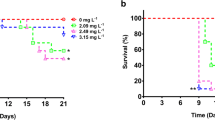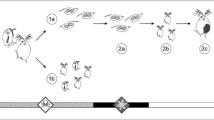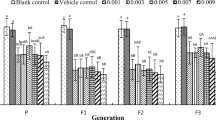Abstract
Trace quantities of pharmaceuticals are continuously being discharged into the environment through domestic and industrial wastewater effluents, causing concern among scientists and regulators regarding potential long-term impacts on aquatic ecosystems. These compounds and their metabolites are constantly interacting with organisms at various life-cycle stages and may differentially influence the development of embryonic, larval, juvenile, and adult stages. To understand the possible cumulative effects of exposure to carbamazepine (CBZ), a multigenerational approach was taken in which survival, reproduction, respiration, growth, brood size, and biomass of Ceriodaphnia dubia were assessed at sublethal concentrations over the course of three successive generations. CBZ exposure significantly decreased fecundity at 196.7 μg/L in the F0 and F1 generations over 2 weeks and acclimatized at 264.6 μg/L in the F2 generation. Similarly, a significant decrease of neonate dry weight was observed at the 196.7 μg/L CBZ treatment in the F1 generation, and it acclimatized at 264.6 μg/L treatment level in the F2 generation. Median time to first brood release was significantly delayed at 264.6 μg/L in the F2 generation, indicating slower maturation. Results over three successive generations are not different than what one would obtain by testing simply the F0 generation. Furthermore, the effects measured were observed at concentrations two orders of magnitude higher than are environmentally relevant, and it is unlikely that CBZ poses a substantial risk to the environment regarding the end points measured in this study. However, additional research through laboratory and field multigenerational studies may be required to understand the overall risk of CBZ to other nontarget organisms.





Similar content being viewed by others
References
Andreozzi R, Marotta R, Pinto G, Pollio A (2002) Carbamazepine in water: persistence in the environment, ozonation treatment and preliminary assessment on algal toxicity. Water Res 36(11):2869–2877
Ankley GT, Brooks BW, Huggett DB, Sumpter JP (2007) Repeating history: pharmaceuticals in the environment. Environ Sci Technol 41:8211–8217
Baer KN, McCoole MD, Overturf MD (2009) Modulation of sex ratios in Daphnia magna following multigenerational exposure to sewage treatment plant effluents. Ecotoxicol Environ Saf 72:1545–1550
Beutler AS, Li SD, Nicol R, Walsh M (2005) Carbamazepine is an inhibitor of histone deacetylases. Life Sci 76:3107–3115
Boxall ABA (2004) Environmental side effects of medication. How are human and veterinary medicines in soils and water bodies affecting human and environmental health? Eur Mol Biol Org Rep 5(12):1110–1116
Brennan SJ, Brougham CA, Roche JJ, Fogarty AM (2006) Multi-generational effects of four selected environmental oestrogens on Daphnia magna. Chemosphere 64:49–55
Brodie MJ (2010) Antiepileptic drug therapy: the story so far. Seizure 19:650–655
Brooks BW, Huggett DB, Boxall ABA (2009) Pharmaceuticals and personal care products: research needs for the next decade. Environ Toxicol Chem 28(12):2469–2472
Brun GL, Bernier M, Losier R, Doe K, Jackman P (2006) Pharmaceutically active compounds in Atlantic Canadian sewage treatment plant effluents and receiving waters, and potential for environmental effects as measured by acute and chronic aquatic toxicity. Environ Toxicol Chem 25(8):2163–2176
Calabrese EJ, Baldwin LA (2003) The hormetic dose-response model is more common than the threshold model in toxicology. Toxicol Sci 71(2):246–250
Cleuvers M (2003) Aquatic ecotoxicity of pharmaceuticals including the assessment of combination effects. Toxicol Lett 142(3):185–194
Cleuvers M (2004) Mixture toxicity of the anti-inflamatory drugs diclofenac, ibuprofen, naproxen, and acetylsalicylic acid. Ecotoxicol Environ Saf 59:309–315
Clubbs RL, Brooks BW (2007) Daphnia magna responses to a vertebrate estrogen receptor agonist and an antagonist: a multigenerational study. Ecotoxicol Environ Saf 67:385–398
Constantine LA, Huggett DB (2010) A comparison of the chronic effects of human pharmaceuticals on two cladocerans, Daphnia magna and Ceriodaphnia dubia. Chemosphere 80:1069–1074
Contardo-Jara V, Lorenza C, Pflugmacherb S, Nützmannc G, Kloasa W, Wiegandd C (2011) Exposure to human pharmaceuticals carbamazepine, ibuprofen and bezafibrate causes molecular effects in Dreissena polymorpha. Aquat Toxicol 105:428–437
Crane M, Watts C, Boucard T (2006) Chronic aquatic environmental risks from exposure to human pharmaceuticals. Toxicol In Vitro 17:525–532
Daughton CG, Ternes TA (1999) Pharmaceuticals and personal care products in the environment: Agents of subtle change? Environ Health Perspect 107(6):907–938
Dietrich S, Florian P, Franz B, Christian L (2010) Single and combined toxicity of pharmaceuticals at environmentally realistic concentrations in Daphnia magna: a multigenerational study. Chemosphere 79:60–66
Dodson S, Merritt C, Shannahan J, Shults C (1999) Low exposure concentrations of atrazine increase male production in Daphnia pulicaria. Environ Toxicol Chem 18:1568–1573
Dussault EB, Balakrishnan VK, Solomon KR, Sibley PK (2008a) Chronic toxicity of the synthetic hormone 17alpha-ethinylestradiol to Chironomus tentans and Hyalella azteca. Environ Toxicol Chem 27(12):2521–2529
Dussault EB, Balakrishnan VK, Sverko ED, Solomon KR, Sibley PK (2008b) Toxicity of human pharmaceuticals and personal care products to benthic invertebrates. Environ Toxicol Chem 27(2):425–432
Fatta-Kassinos D, Kalavrouziotis IK, Koukoulakis PH, Vasquez MI (2011) The risks associated with wastewater reuse and xenobiotics in the agroecological environment. Sci Total Environ 409:3555–3563
Fent K, Weston AA, Caminada D (2006) Ecotoxicology of human pharmaceuticals. Aquat Toxicol 76:122–159
Ferrari B, Nicklas Paxéus N, Giudice RL, Pollio A, Garric J (2003) Ecotoxicological impact of pharmaceuticals found in treated wastewaters: study of carbamazepine, clofibric acid, and diclofenac. Ecotoxicol Environ Saf 55:359–370
Ferrari B, Mons R, Vollat B, Fraysse B, Paxe N, Giudicer I et al (2004) Environmental risk assessment of six human pharmaceuticals: Are the current environmental risk assessment procedures sufficient for the protection of the aquatic environment? Environ Toxicol Chem 23(5):1344–1354
Focazio MJ, Kolpin DW, Barnes KK, Furlong ET, Meyer MT, Zaugg SD et al (2008) A national reconnaissance for pharmaceuticals and other organic wastewater contaminants in the United States II) untreated drinking water sources. Sci Total Environ 402:201–216
Glassmeyer ST, Furlong ET, Kolpin DW, Cahill JD, Zaugg SD, Werner SL et al (2005) Transport of chemical and microbial compounds from known wastewater discharges: potential for use as indicators of human fecal contamination. Environ Sci Technol 39(14):5157–5169
Gust M, Mouthon J, Queau H, Dussart C, Buronfosse T, Garric J (2011) Natural variability and response interpretation of fecundity, vertebrate-like sex-steroid levels and energy status in the New Zealand mudsnail Potamopyrgus antipodarum (Gray). Gen Comp Endocrinol 172:243–250
Haeba MH, Hilscherová K, Mazurová E, Bláha L (2008) Selected endocrine disrupting compounds (vinclozolin, flutamide, ketoconazole and dicofol): effects on survival, occurrence of males, growth, molting and reproduction of Daphnia magna. Environ Sci Pollut Res 15(3):222–227
Heckmann LH, Callaghan A, Hooper HL, Connon R, Hutchinson TH, Maund SJ et al (2007) Chronic toxicity of ibuprofen to Daphnia magna: effects on life history traits and population dynamics. Toxicol Lett 172:137–145
Jos A, Repetto G, Rios JC, Hazen MJ, Molero ML, Peso AD et al (2003) Ecotoxicological evaluation of carbamazepine using six different model systems with eighteen endpoints. Toxicol In Vitro 17(5):525–532
Kim Y, Choi K, Jung J, Park S, Kim PG, Park J (2007) Aquatic toxicity of acetaminophen, carbamazepine, cimetidine, diltiazem and six major sulfonamides, and their potential ecological risks in Korea. Environ Int 33:370–375
Klüttgen B, Kuntz N, Ratte HT (1996) Combined effects of 3,4-dichloroaniline and food concentration on life-table data of two related cladocerans, Daphnia magna and Ceriodaphnia quadrangula. Chemosphere 32:2015–2028
Knight JT, Waller WT (1992) Influence of the addition of cerophyl on the Selenastrum capricornutum diet of the cladoceran Ceriodaphnia dubia. Environ Toxicol Chem 11:521–534
Kolpin DW, Furlong ET, Meyer MT, Thurman EM, Zaugg SD, Barber LB et al (2002) Pharmaceuticals, hormones, and other organic wastewater contaminants in US streams, 1999–2000: a national reconnaissance. Environ Sci Technol 36(6):1202–1211
Kolpin DW, Skopec M, Meyer MT, Furlong ET, Zaugg SD (2004) Urban contribution of pharmaceuticals and other organic wastewater contaminants to streams during differing flow conditions. Sci Total Environ 328:119–130
Kooijman SALM (2000) Dynamic energy and mass budgets in biological systems. Cambridge University Press, Cambridge
la Farré M, Pérez S, Kantiani L, Barceló D (2008) Fate and toxicity of emerging pollutants, their metabolites and transformation products in the aquatic environment. Trends Anal Chem 27(11):991–1007
Leclercq MO, Mathieu Ó, Gomez E, Casellas C, Fenet H, Hillaire-Buys D (2009) Presence and fate of carbamazepine, oxcarbazepine, and seven of their metabolites at wastewater treatment plants. Arch Environ Contam Toxicol 56(3):408–415
Lürling M, Sargant E, Roessink I (2005) Life-history consequences for Daphnia pulex exposed to pharmaceutical carbamazepine. Environ Toxicol 21(2):172–180
Malarvizhi A, Kavitha C, Saravanan M, Ramesh M (2012) Carabamazepine (CBZ) induced enzymatic stress in gill, liver, and muscle of a common carp. Cyprinus carpio J King Saud Univ 24(2):179–186
Massarin S, Alonzo F, Garcia-Sanchez L, Gilbin R, Garnier-Laplace J, Poggiale JC (2010) Effects of chronic uranium exposure on life history and physiology of Daphnia magna over three successive generations. Aquat Toxicol 99:309–319
Meredith-Williams M, Carter LJ, Fussell R, Raffaelli D, Ashauer R, Boxall ABA (2012) Uptake and depuration of pharmaceuticals in aquatic invertebrates. Arch Environ Pollut 165:250–258
Metcalfe CD, Koenig BG, Bennie DT, Servos M, Ternes TA, Hirsch R (2003) Occurrence of neutral and acidic drugs in the effluents of Canadian sewage treatment plants. Arch Environ Toxicol Chem 22:2872–2880
Metcalfe CD, Miao X-S, Hua W, Letcher R, Servos M (2004) Pharmaceuticals in the Canadian environment. In: Kümmerer K (ed) Pharmaceuticals in the environment. Springer, Heidelberg, pp 67–90
Miao XS, Metcalfe CD (2003) Determination of carbamazepine and its metabolites in aqueous samples using liquid chromatography–electrospray tandem mass spectrometry. Anal Chem 75:3731–3738
Miao XS, Yang JJ, Metacalfe CD (2005) Carbamazepine and its metabolites in wastewater and in biosolids in a municipal wastewater treatment plant. Environ Sci Technol 39(19):7469–7475
Muller EB, Nisbet RM, Berkley HA (2010) Sub-lethal toxicant effects with dynamic energy budget theory: model formulation. Ecotoxicology 19:48–60
Nentwig G, Oetken M, Oehlmann J (2004) Effects of pharmaceuticals on aquatic invertebrates: The example of carbamazepine and clofibric acid. In: Kümmerer K (ed) Pharmaceuticals in the environment. Sources, fate, effects and risks. Springer, Berlin, pp 195–208
Nisbet RM, McCauley E, Johnson LR (2010) Dynamic energy budget theory and population ecology: Lessons from Daphnia. Philos Trans R Soc Lond B Biol Sci 365(1557):3541–3552
Norberg TJ, Mount DI (1985) Diets for Ceriodaphnia reticulate life cycle tests. In: Cardwell RD, Purdy R, Bahner RC (eds) Aquatic toxicology and hazard assessment. 7th Symposium, ASTM STP 854. American Society for Testing and Materials, Philadelphia, pp 42–52
Oetken M, Nentwig G, Löffler D, Ternes T, Oehlmann J (2005) Effects of pharmaceuticals on aquatic invertebrates. Part I. The antiepileptic drug carbamazepine. Arch Environ Contam Toxicol 49:353–361
Olmstead AW, LeBlanc GA (2000) Effects of endocrine-active chemicals on the development of sex characteristics of Daphnia magna. Arch Environ Contam Toxicol 19(8):2107–2113
Olmstead AW, LeBlanc GA (2001) Temporal and quantitative changes in sexual reproductive cycling of the cladoceran Daphnia magna by a juvenile hormone analog. J Exp Zool 290(2):148–155
Overturf MD, Overturf CL, Baxter D, Hala DN, Constantine L, Venables B et al (2011) Early life-stage toxicity of eight pharmaceuticals to the fathead minnow, Pimephales promelas. Arch Environ Contam Toxicol 62:455–464
Phyu YL, Palmer CG, Warne MS, Hose GC, Chapman JC, Lim RP (2011) A comparison of mixture toxicity assessment: examining the chronic toxicity of atrazine, permethrin and chlorothalonil in mixtures to Ceriodaphnia cf. dubia. Chemosphere 85(10):1568–1573
Quinn B, Gagné F, Blaise C (2004) Oxidative metabolism activity in Hydra attenuata exposed to carbamazepine. Fresenius Environ Bull 13(8):1–6
Quinn B, Gagné F, Blaise C (2008) An investigation into the acute and chronic toxicity of eleven pharmaceuticals (and their solvents) found in wastewater effluent on the cnidarian, Hydra attenuata. Sci Total Environ 389:306–314
Ramakrishnan L, DeSaer C (2011) Carbamazepine inhibits distinct chemoconvulsant-induced seizure-like activity in Dugesia tigrina. Pharmacol Biochem Behav 99:665–670
Ramirez M, Sanchez MM, Garcia MYG, Rodriguez OA, Espinoza SG, Luna R et al (2007) Effect of benomile fungicide in the demographics parameters of Ceriodaphnia reticulata Jurine, 1820 (Crustacea: Cladocera). J Environ Sci Health 42:1461–1466
Rayburn WF, Gonzalez CL, Parker KM, Christensen HD (2004) Chronic prenatal exposure to carbamazepine and behavior effects on mice offspring. Am J Obstet Gynecol 190:517–521
Rodgher S, Espíndol ELG (2008) Effects of interactions between algal densities and cadmium concentrations on Ceriodaphnia dubia fecundity and survival. Ecotoxicol Environ Saf 71(3):765–773
Rose RM, Warne MS, Lim RP (2002) Food concentration affects the life history responses of Ceriodaphnia cf. dubia to chemicals with different mechanisms of action. Ecotoxicol Environ Saf 51(2):106–114
Shurin JB, Dodson SI (1997) Sub-lethal toxic effects of cyanobacteria and nonylphenol on environmental sex determination and development in Daphnia. Environ Toxicol Chem 16(6):1269–1276
Tixier C, Singer HP, Oellers S, Muller SR (2003) Occurrence and fate of carbamazepine, clofibric acid and diclofenace, ibuprofen, ketoprofen and naproxen in surface waters. Environ Sci Technol 37(6):1061–1068
United States Environmental Protection Agency (1986) Taxonomy of Ceriodaphnia (Crustacea: Cladocera) in U.S. Environmental Protection Agency cultures. In: DB Berner (ed). USEPA Environmental Monitoring and Support Laboratory, Cincinnati, OH, EPA/600/4-86/032. http://cfpub.epa.gov/ols/catalog/catalog_display.cfm?&FIELD1=AUTHOR&INPUT1=Berner%20AND%20D.%20AND%20B.&TYPE1=ALL&item_count=1
United States Environmental Protection Agency (1991) Guidelines for culturing the Japanese medaka, Oryzias latipes. EPA-60091 064:38
United States Environmental Protection Agency (2002a) Methods for measuring the acute toxicity of effluents and receiving waters to freshwater and marine organisms, 5th edn. EPA/821/R-02/012. USEPA, Washington DC
United States Environmental Protection Agency (2002b) Short-term methods for estimating the chronic toxicity of effluents and receiving waters to freshwater organisms, 4th edn. EPA/821/R-02/013. USEPA, Washington DC
van den Brandhof EJ, Montforts M (2010) Fish embryo toxicity of carbamazepine, diclofenac and metoprolol. Ecotoxicol Environ Saf 73:1862–1866
Wang HY, Olmstead AW, Li H, LeBlanc GA (2005) The screening of chemicals for juvenoid-related endocrine activity using the water flea Daphnia magna. Aquat Toxicol 74:193–204
Ying GG, Kookana RS, Kolpin DW (2009) Occurrence and removal of pharmaceutically active compounds in sewage treatment plants with different technologies. J Environ Monit 11:1498–1505
Zhang Y, Geißen SU (2010) Prediction of carbamazepine in sewage treatment plant effluents and its implications for control strategies of pharmaceutical aquatic contamination. Chemosphere 80:1345–1352
Zhang W, Zhang M, Lin K, Sun W, Xiong B, Guo M et al (2012) Eco-toxicological effect of carbamazepine on Scenedesmus obliquus and Chlorella pyrenoidosa. Environ Toxicol Pharmacol 33(2):344–352
Acknowledgments
We thank Sarah Andrewartha for respirometer use and Barney Venables, Tom Waller, Regina Edziyie, and Raji Dhital for useful discussions.
Conflict of interest
The use of trade, firm, or brand names in this article is for identification purposes only and does not constitute endorsement by the authors.
Author information
Authors and Affiliations
Corresponding author
Electronic supplementary material
Below is the link to the electronic supplementary material.
Rights and permissions
About this article
Cite this article
Lamichhane, K., Garcia, S.N., Huggett, D.B. et al. Chronic Effects of Carbamazepine on Life-History Strategies of Ceriodaphnia dubia in Three Successive Generations. Arch Environ Contam Toxicol 64, 427–438 (2013). https://doi.org/10.1007/s00244-012-9845-5
Received:
Accepted:
Published:
Issue Date:
DOI: https://doi.org/10.1007/s00244-012-9845-5




